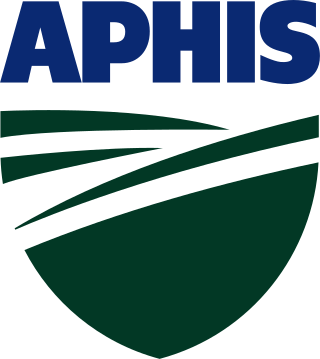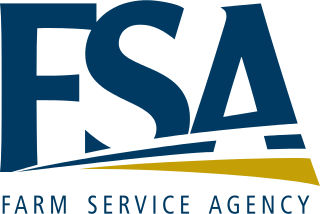Related Research Articles

The United States Department of Agriculture (USDA) is an executive department of the United States federal government that aims to meet the needs of commercial farming and livestock food production, promotes agricultural trade and production, works to assure food safety, protects natural resources, fosters rural communities and works to end hunger in the United States and internationally. It is headed by the secretary of agriculture, who reports directly to the president of the United States and is a member of the president's Cabinet. The current secretary is Tom Vilsack, who has served since February 24, 2021.
The United States Rural Utilities Service (RUS) administers programs that provide infrastructure or infrastructure improvements to rural communities. These include water and waste treatment, electric power, and telecommunications services. It is an operating unit of the USDA Rural Development agency of the United States Department of Agriculture (USDA). It was created in 1935 as the Rural Electrification Administration (REA), a New Deal agency promoting rural electrification.

The Agricultural Research Service (ARS) is the principal in-house research agency of the United States Department of Agriculture (USDA). ARS is one of four agencies in USDA's Research, Education and Economics mission area. ARS is charged with extending the nation's scientific knowledge and solving agricultural problems through its four national program areas: nutrition, food safety and quality; animal production and protection; natural resources and sustainable agricultural systems; and crop production and protection. ARS research focuses on solving problems affecting Americans every day. The ARS Headquarters is located in the Jamie L. Whitten Building on Independence Avenue in Washington, D.C., and the headquarters staff is located at the George Washington Carver Center (GWCC) in Beltsville, Maryland. For 2018, its budget was $1.2 billion.

The Animal and Plant Health Inspection Service (APHIS) is an agency of the United States Department of Agriculture (USDA) based in Riverdale, Maryland responsible for protecting animal health, animal welfare, and plant health. APHIS is the lead agency for collaboration with other agencies to protect U.S. agriculture from invasive pests and diseases. APHIS's PPQ is the National Plant Protection Organization for the U.S., and the agency's head of veterinary services/veterinary Deputy Administrator is the Chief Veterinary Officer of the United States.

The Farm Service Agency (FSA) is the United States Department of Agriculture agency that was formed by merging the farm loan portfolio and staff of the Farmers Home Administration (FmHA) and the Agricultural Stabilization and Conservation Service (ASCS). The Farm Service Agency implements agricultural policy, administers credit and loan programs, and manages conservation, commodity, disaster, and farm marketing programs through a national network of offices. The Administrator of FSA reports to the Under Secretary of Agriculture for Farm Production and Conservation. The current administrator is Zach Ducheneaux. The FSA of each state is led by a politically appointed State Executive Director (SED).

The Food and Nutrition Service (FNS) is an agency of the United States Department of Agriculture (USDA). The FNS is the federal agency responsible for administering the nation’s domestic nutrition assistance programs. The service helps to address the issue of hunger in the United States.
The Agricultural Marketing Service (AMS) is an agency of the United States Department of Agriculture; it maintains programs in five commodity areas: cotton and tobacco; dairy; fruit and vegetable; livestock and seed; and poultry. These programs provide testing, standardization, grading and market news services for those commodities, and oversee marketing agreements and orders, administer research and promotion programs, and purchase commodities for federal food programs. The AMS enforces certain federal laws such as the Perishable Agricultural Commodities Act and the Federal Seed Act. The AMS budget is $1.2 billion. It is headquartered in the Jamie L. Whitten Building in Washington, D.C.
The Rural Business-Cooperative Service is one of three agencies within USDA Rural Development responsible for administering various economic development programs to rural communities in the United States and its territories. Because these three agencies are closely aligned, they are commonly referred to as the USDA Rural Development, Business & Cooperative Programs.
The Rural Housing Service (RHS) is an agency of the United States Department of Agriculture (USDA). Located within the Department's Rural Development mission area. RHS operates a broad range of programs to provide moderate- low- and very-low-income Americans in rural communities with:
The Commodity Credit Corporation (CCC) is a wholly owned United States government corporation that was created in 1933 to "stabilize, support, and protect farm income and prices". The CCC is authorized to buy, sell, lend, make payments, and engage in other activities for the purpose of increasing production, stabilizing prices, assuring adequate supplies, and facilitating the efficient marketing of agricultural commodities.
A loan guarantee, in finance, is a promise by one party to assume the debt obligation of a borrower if that borrower defaults. A guarantee can be limited or unlimited, making the guarantor liable for only a portion or all of the debt.
The Child and Adult Care Food Program (CACFP) is a type of United States federal assistance provided by the Food and Nutrition Service (FNS) of the United States Department of Agriculture (USDA) to states in order to provide a daily subsidized food service for an estimated 3.3 million children and 120,000 elderly or mentally or physically impaired adults in non-residential, day-care settings. It is a branch within the Policy and Program Development Division of the Child nutrition programs, along with the School Programs Branch, which runs the National School Lunch Program. The program is commonly referred to as the Child Care, Child Care Food, Adult Care, or Adult Care Food Program, and is often operating in conjunction with other child and adult day-care programs, such as the Head Start. Its federal identification number, or CFDA number, is 10.558. Section 17 of the National School Lunch Act, and USDA issues the program regulations under 7 CFR part 226.

USDA Rural Development (RD) is a mission area within the United States Department of Agriculture which runs programs intended to improve the economy and quality of life in rural parts of the United States.

The Consolidated Farm and Rural Development Act of 1972 or Con Act authorized a major expansion of USDA lending activities, which at the time were administered by Farmers Home Administration (FmHA). The legislation was originally enacted as the Consolidated Farmers Home Administration Act of 1961. In 1972, this title was changed to the Consolidated Farm and Rural Development Act, and is often referred to as the Con Act.

The Consolidated Farm and Rural Development Act of 1961 authorized a major expansion of USDA lending activities, which at the time were administered by Farmers Home Administration (FmHA), but now through the Farm Service Agency. The legislation was originally enacted as the Consolidated Farmers Home Administration Act of 1961.

The Food, Agriculture, Conservation, and Trade (FACT) Act of 1990 — P.L. 101-624 was a 5-year omnibus farm bill that passed Congress and was signed into law.
Section 516 grants are a USDA farm labor housing program authorized by Section 516 of the Housing Act of 1949. Qualified nonprofit organizations, Indian tribes, or public bodies obtain grants for the development cost of farm labor housing. Grants may be used simultaneously with Section 514 loans if the housing, for which there is a “pressing need,” will not be built without assistance from the Rural Housing Service (RHS). Grants may be made for up to 90% of the development cost of the housing. In a given fiscal year, up to 10% of the Section 516 funds shall be for domestic and migrant farm worker housing. Applicants must contribute at least 10% of the total development costs from their own resources or from other sources including Section 514 loans. Funds may be used to buy, build, or improve housing and related facilities for farm workers, and to purchase and improve the land where the housing will be located, including installation of streets, water supply and waste disposal systems, parking areas, and driveways as well as for the purchase and installation of appliances such as ranges, refrigerators, and clothes washers and dryers. Related facilities may include the maintenance workshop, recreation center, small infirmary, laundry room, day care center, and office and living quarters for the resident manager.
Section 502 loans are a rural housing loan program, administered by the Rural Housing Service (RHS), authorized under Section 502 of the Housing Act of 1949. Borrowers may obtain loans for purchasing or repairing new or existing single-family housing. Loans are made directly by RHS or by private lenders with a USDA guarantee. Borrowers with income of 80% or less of the area median may be eligible for 33- year direct loans and may receive payment assistance to bring the interest rate to as low as 1%. In a given fiscal year, at least 40% of the units financed under this section must be made available only to very low-income families or individuals. In addition, families or individuals at or below 60% of the area median may qualify for loan terms up to 38 years. Borrowers must have the means to repay the loans, but be unable to secure reasonable credit terms elsewhere. Borrowers with income of up to 115% of the area median may be eligible for 30-year guaranteed loans from private lenders. Priority is given to first-time home buyers, and the RHS may require that borrowers complete a home ownership counseling program.
The Rural Community Advancement Program is a program established by the 1996 farm bill under which USDA is authorized to provide state rural development block grants, direct and guaranteed loans, and other assistance to meet rural development needs across the country. Program funding is allocated to three accounts: (1) community facilities, (2) rural utilities, and (3) rural business and cooperative development.
A USDA Home Loan from the USDA loan program, also known as the USDA Rural Development Guaranteed Housing Loan Program, is a mortgage loan offered to rural property owners by the United States Department of Agriculture, Rural Development.
References
 This article incorporates public domain material from Jasper Womach. Report for Congress: Agriculture: A Glossary of Terms, Programs, and Laws, 2005 Edition (PDF). Congressional Research Service.
This article incorporates public domain material from Jasper Womach. Report for Congress: Agriculture: A Glossary of Terms, Programs, and Laws, 2005 Edition (PDF). Congressional Research Service.
- ↑ "USDA Community Facilities Programs" . Retrieved 20 Feb 2024.